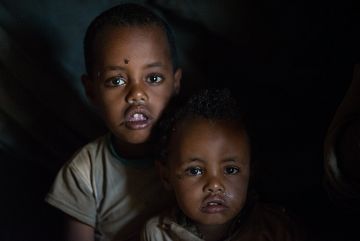New study provides valuable findings to support improved pneumonia diagnostic aids
1 July 2021
Researchers testing a newly developed video-based reference tool to evaluate new automated respiratory rate (RR) diagnostic aids in children under five found that breathing measurements carried out by medical professionals using the tool were in substantial agreement for older children but differed considerably for those younger than one year. These findings further highlight the challenges in country RR in younger children.
The research — led by Malaria Consortium — suggests further development of the tool to accurately evaluate new diagnostic aids in infants who have the highest rates of pneumonia, the leading infectious cause of death in children under five. The study, conducted in Ethiopia between April and September 2019, was recently published in Journal of Tropical Pediatrics.
In low-resource settings, community health workers around the world currently assess RR by manually counting breaths of suspected pneumonia cases. The World Health Organisation guidelines recommend health workers counting breaths for one full minute in calm children, under real-life circumstances, however, younger children seldom remain calm for a full minute, making it challenging for health workers to accurately identify and count breaths.
Five medical professionals assessed 51 video recordings each of children 0–59 months with a cough and difficulty breathing to measure the RR, an indicator of pneumonia. Agreement measures on fast breathing differed substantially between age groups. Among the youngest children, under two months, agreement on fast breathing was moderate. In the older age groups, 2–11 and 12–59 months, agreement on fast breathing was almost perfect and substantial, respectively, proving the effectiveness of the tool for older children.
The new video-based reference tool allows users to annotate breaths and distortions, such as movement and crying, by adding time markers on the video footage. Distortions can be excluded from the readings to allow for more flexibility in calculating RR, matching the RR measurements of new diagnostic aids, which often account for distortions automatically.
“We have been leading work on better understanding how to improve pneumonia diagnostic aids and key to this is how best to evaluate new devices as they develop. Our study provides some valuable findings to support this work and we hope will support new technologies to better address pneumonia diagnosis,” said Kevin Baker, Principal Investigator and Research Advisor at Malaria Consortium.
Considering distortions
The study also established that the RR agreement was higher in videos where medical professionals noted less distortion or movement. The age group of the child and distortion marked seemed to be correlated. Videos of children 12–59 months showed a significantly lower degree of distortion than videos of children under two months and 2–11 months.
The researchers therefore recommend that accuracy and reliability of new RR measuring diagnostic aids must first be validated against a robust reference standard before they can be considered appropriate for agitated children and infants. Inaccurate RR assessments can result in misdiagnosis of suspected pneumonia with potentially fatal consequences due to inappropriate or no treatment.
Keywords: Research
Related content
11 November 2020
Using artificial intelligence on mobile devices to determine respiratory rate (AIRR)
Latest news
- International summit calls for AMR accountability in public health interventions21st March 2024
- Global SMC community celebrates new milestone at SMC Alliance Annual Meeting in Nigeria6th March 2024
- Scaling up key interventions could halve pneumonia-related childhood mortality13th February 2024
- Malaria Consortium and eGov Foundation join Mozambique’s national malaria programme to digitalise seasonal malaria chemoprevention campaigns8th February 2024
- World’s first malaria vaccine rollout launched in Cameroon22nd January 2024
- Digital solutions driving equitable access to health6th December 2023